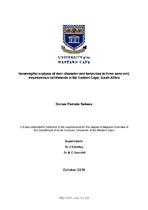| dc.contributor.advisor | Grenfell, Michael | |
| dc.contributor.advisor | Glenday, Julia | |
| dc.contributor.author | Sekese, Siviwe Pamela | |
| dc.date.accessioned | 2020-11-03T07:21:00Z | |
| dc.date.available | 2021-01-01T22:10:05Z | |
| dc.date.issued | 2019 | |
| dc.identifier.uri | http://hdl.handle.net/11394/7412 | |
| dc.description | >Magister Scientiae - MSc | en_US |
| dc.description.abstract | The analysis of what controls why rivers are the way they are, and how and why they change is crucial in predicting river dynamics and deriving classification systems that can assist management. A variety of factors control the pattern of fluvial styles in a river system across spatial scales. The geomorphic response of a river to an individual control, such as stream power for example, will vary due to a combination of other contributing factors such as geology and climate. | en_US |
| dc.language.iso | en | en_US |
| dc.publisher | University of Western Cape | en_US |
| dc.subject | Geomorphic analysis | en_US |
| dc.subject | Eastern Cape | en_US |
| dc.subject | River dynamics | en_US |
| dc.subject | Climate change | en_US |
| dc.subject | Geology | en_US |
| dc.title | Geomorphic analysis of river character and behaviour in three semi-arid, mountainous catchments in the Eastern Cape, South Africa | en_US |
| dc.rights.holder | University of Western Cape | en_US |

